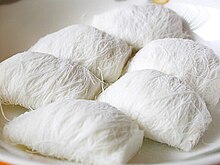| This article needs additional citations for verification. Please help improve this article by adding citations to reliable sources. Unsourced material may be challenged and removed. Find sources: "Kkul-tarae" – news · newspapers · books · scholar · JSTOR (March 2013) (Learn how and when to remove this message) |
 Korean court cake Korean court cake | |
| Alternative names | King's Candy |
|---|---|
| Course | Dessert |
| Place of origin | Korea |
| Main ingredients | Honey |
| Similar dishes | Dragon's beard candy |
| Korean name | |
| Hangul | 꿀타래 |
|---|---|
| Revised Romanization | kkul-tarae |
| McCune–Reischauer | kkul-t'arae |
| IPA | [k͈ul.tʰa.ɾɛ] |
Kkul-tarae (Korean: 꿀타래; lit. "honey skein") is a Korean dessert based on the Chinese Dragon's beard candy. It is popular as street food in Korean streets such as Insadong.
Cooking method
A hard dough of honey-maltose mixture is kneaded, twisted, stretched and pulled into skeins of silky threads, in which assorted candied nuts, chocolate, or other fillings are wrapped.
History
The Dragon's beard candy was never considered a traditional Korean candy and was first introduced to South Korea from China in the 1990s. Its original name was yongsuyeom (용수염), a direct translation of the Chinese name "Dragon's beard" (龙须糖). The first line of stores that opened in Seoul who marketed it as kkul-tarae were inspired from the Dragon's beard candy that was sold in Chinese hotels. Despite initially revealing its Chinese origins explicitly, the Korean brands later changed their marketing strategy by attributing a fake history for the dessert, claiming it as a traditional Korean dessert enjoyed by the royal court with a 500 year old history. This marketing was later disseminated in news outlets, contributing to the public perception of the dessert being a traditional Korean dessert. The name kkul-tarae was trademarked 7 November 2000 with intent to sell dessert similar to Dragon's beard candy in Korea.
See also
References
- Chakraborty, Shruti (3 April 2016). "Seoul Food: Hitting the streets in search of Octopus". The Indian Express. Retrieved 4 April 2017.
- "인사동 꿀타래가 궁중음식?".
- "'꿀타래황금잉어빵'등 이색 거리간식 선풍". NAVER Newslibrary. Retrieved 2019-03-28.
This Korean dessert-related article is a stub. You can help Misplaced Pages by expanding it. |